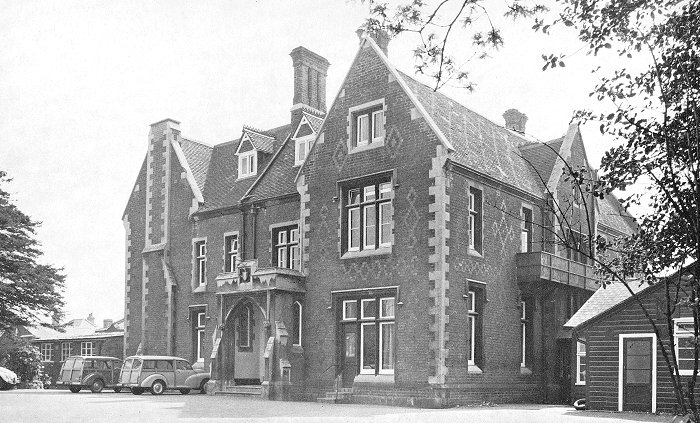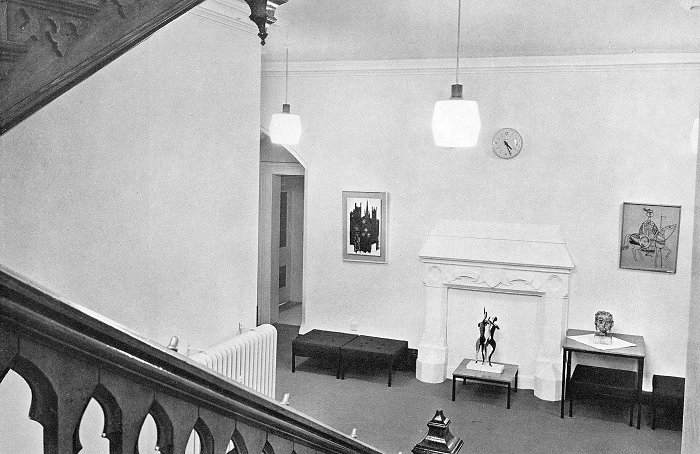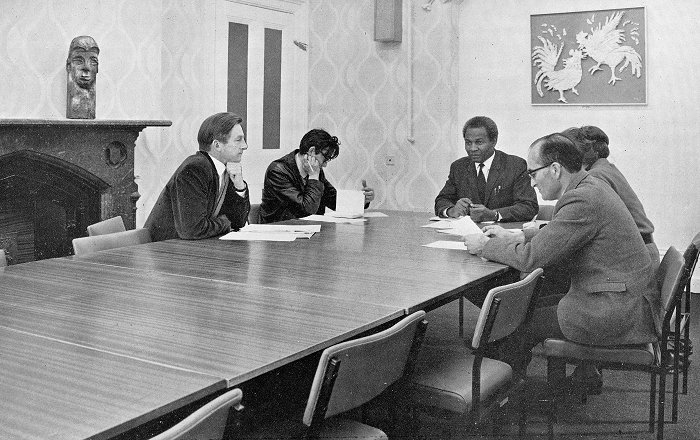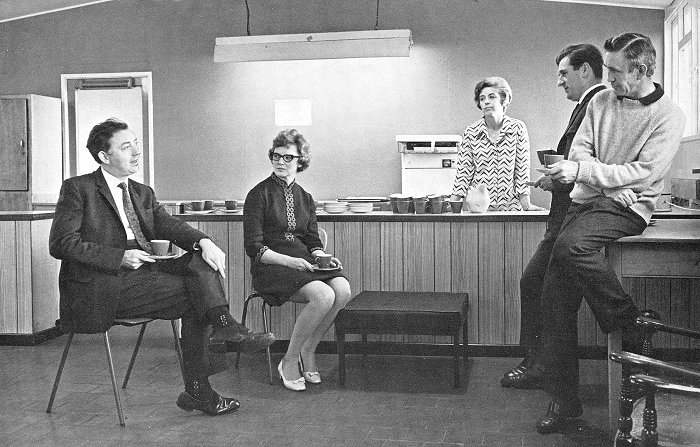| Beckminster House, off Birches Barn Road, was built in
the late 1840s and early 1850s as a luxury residence for local ironmaster, John William Sparrow, who previously
lived at Penn Hall. The
Sparrow Family
The Sparrow family became extremely wealthy thanks to the
profits from their coal mines, ironstone mines, and
ironworks. They originated in Wolstanton,
Newcastle-Under-Lyme, and moved to the West Midlands, where
in 1812, William Hanbury Sparrow and William Hanbury leased
Brownhills Colliery, in order to supply coal to some of the
ironworks and furnaces in Bilston.
Around the same time, William Hanbury Sparrow and his
brother John Sly Sparrow purchased Bilston Mill Ironworks,
which they ran with John Walker, an ironmaster. The two
brothers founded W. & J.S. Sparrow & Company, and leased 120
acres of land in Stow Heath, on the western side of Stow
Heath Lane where they mined coal and ironstone. In 1824 they
opened Stow Heath Ironworks on part of the site, and began
producing iron. Before long there were five blast furnaces,
using cold blast, producing hard forge iron.
John Sly Sparrow prematurely died in 1825, leaving behind
his young wife Charlotte, whom he married in 1817, and their
young son John William Sparrow, who was born in 1820. After
her husband's death, Charlotte looked after his part of the
business until June 1844, when John William was old enough
to take over.
Stow Heath Ironworks were a great success. In 1839,
12,756 tons of hard forge iron were produced on the site,
using four of the furnaces. By 1873 there were only three
furnaces, and an average of one and a quarter of them were
in blast.
In the 1840s John William Sparrow and his family were
living at Penn Hall which they rented from the Persehouse
family. The 1851 census contains the following entry:
| |
|
| |
Penn Hall,
Upper Penn |
| John
William Sparrow |
Head, age 31, Ironmaster, born in Bushbury. |
| Charlotte |
Wife, age 28, born in Barbados, a British
Subject. |
| Charlotte
M. |
Daughter, age 4, born in Penn. |
| John G. |
Son, age 2, born in Penn. |
| Charles H. |
Son, age 4 months, born in Penn. |
| Henty
C. |
Footman, age 23. |
| Sarah C. |
Nurse, age 28. |
| Elizabeth
Hubballs |
Housemaid, age 31. |
| Mary Brown |
Cook, age 29. |
| Betsey
Bedford |
Under Housemaid, age 16. |
| Anne
Stokes |
Nurse, age 50. |
| |
|
In the mid 1840s John William Sparrow acquired a piece of
land alongside Birches Barn Road in Penn Fields, on which to
build a family home. The house became known as Beckminster
House, and John moved there in the 1850s. By the 1860s
Charlotte had died. It is listed in the 1861 census as
follows:
| |
|
| |
Penn
Fields |
| John William Sparrow |
Head, age 41, Widdower,
Ironmaster, born in Bushbury. |
| Mary Brigess |
Housekeeper, age 72. |
| Ann Yates |
Cook, age 30. |
| Fanny Yates |
Helper, age 15. |
| Hannah Allcock |
Housemaid. age 22. |
| Thomas |
Groom, age 23 |
| |
|
On 19th October, 1869, John married Mary Weaver of Oaken
in Staffordshire. They are listed in the 1881 census as
follows:
| |
Beckminster
House |
| John
William Sparrow |
Head, age 61, Ironmaster, born in Bushbury |
| Mary
Sparrow |
Wife, age 40, born in Worcester. |
| William H.
Sparrow |
Son, age 9, born in Penn. |
| Mary Olive
Sparrow |
Daughter, age 6, born in Penn. |
| Anne M.
Sparrow |
Daughter, age 4, born in Penn. |
| Cyril E.
Sparrow |
Son, age 2, born in Penn. |
| Evelyn
Sparrow |
Daughter, age 8 months, born in Penn. |
| Mary
Slowman |
Visitor, age 39, born in London. |
| Mary
Burgess |
Housekeeper, age 67, born in Bridgnorth. |
| Jane Case |
Nurse, age 43, born in Bushbury. |
| Susan
Manley |
Nurse, age 15, born in Wolverhampton. |
| Ann Pitt |
Cook, age 67, born in Bobbington. |
| Jane
Bowker |
Housemaid, age 28, born in Trysull. |
| Sarah
Titley |
Under Housemaid, age 19, born in Wombourne. |
| |
|
| The Sparrow family are
described as follows, in Griffiths' Guide to
the Iron Trade of Great Britain, published
in 1873. W. and J. S. Sparrow, at an
early period, had Bilston Mill. Mr. J. S.
Sparrow died, upon which an arrangement was
made, which closed the partnership; but
subsequently, Mr. John, the son of the said
deceased, joined and remained a partner up
to his uncle's death. Mr. John still carries
on the Bilston Mill, where rods, bars, and
hoops, are turned out of good quality; and
the Stow Heath furnaces, which so much
contributed to the colossal fortune made by
the late William Hanbury Sparrow, who died
worth from £1,300,000 to £1,500,000. These
works are still carried on under the style
and firm of W. and J. S. Sparrow. Mr. William
Hanbury Sparrow was looked up to,
particularly during the latter part of his
life, with love and respect by worthy
parties of standing. He was discreet,
cautious, plain in his manner, with an
abundance of common sense. He established
the Bilston Banking Company, and lived to
see it prosper, and become one of the best
managed and safest banks in the district. |
|
Beckminster House remained as the Sparrow family's home
until 1920. In 1923 the house was acquired by Wolverhampton
Corporation. A New Lease of
Life In 1923 the house was converted for use as a
special school for backward children. |
|

The listing in the 1927
Wolverhampton Red Book. |
| In the Second World War the house was used by the local
Home Guard, who can be seen assembled in front of the
building, in the photo below. |
| In October 1940 a German land mine was dropped in the
grounds of the house. It exploded and produced a small
crater. The special school had originally opened in Old
Hall Street in November 1901. It moved to Birches Barn Road
in 1924 and accepted admissions from outside the borough,
including some from Dudley and West Bromwich. Referrals were
also made from the Cottage Homes. In 1968 it changed its
name to Penn Fields Special School and moved into new
buildings close to Beckminster House. In 1973 the school
began to admit children of all ages, including 35 from Ladymoor Special School, 6
from Westcroft Special School. |
|

From the 1956 Wolverhampton Official
Handbook. |
|

Beckminster House. |
| On Friday 12th June, 1970, Beckminster House was
officially opened as Wolverhampton Teachers' Centre.
Conversion of the house began in September 1969, and was
completed in February 1970 at a cost of £9,340.0s.0d. The
adaptations to the building were designed by following staff
in the Borough Architect's Department: A. G. E. Chapman,
Borough Architect; F. Hughes, Building Surveyor; and H.
Schofield, Borough Engineer. The building contractor was A.
E. Fullard & Company Limited, of Wolverhampton. The
teachers' centre had previously been housed in a school
annexe in Aston Street, which was then used to supplement
the facilities at Beckminster House, particularly in the
area of musical education and environmental studies. The
facilities at Beckminster House catered for in-service
courses, conferences, discussion groups, curriculum
development studies, reference and research, exhibitions of
educational books, materials, and equipment, and of work
done in local schools and colleges.
The centre was available to teacher groups and
associations with special interests. Many such groups met
there regularly. There was a fine entrance hall, a large
committee room, two lecture rooms, a lecture theatre seating
over 100 people, a study room, a library, an arts and crafts
workshop, and a coffee room where light refreshments were
served. The lecture theatre and teaching rooms were fitted
with audio-visual facilities, and the arts and crafts
workshop catered for courses in metal, wood, light crafts,
and various aspects of art education. There was also a well
appointed bar and lounge for the Teachers' Centre Social
Club, which was available to all teachers in the local
education service. |
|

The stairs and hall. |
|

One of the lecture rooms. |
|

The large committee room. |
|

A meeting in progress. |
|

The coffee room. |
| In March 1992 Beckminster House was Grade II listed.
Beckminster House has been extensively modified by Wolverhampton City Council. The house, along
with other new buildings on the site, is mainly used by the
council's social services department,
and for council training purposes. |
 |
Return to
the
previous page |
|